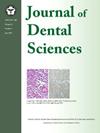In vitro evaluation of novel composite bioceramic filaments for alveolar bone regeneration
IF 3.1
3区 医学
Q1 DENTISTRY, ORAL SURGERY & MEDICINE
引用次数: 0
Abstract
Background/purpose
Alveolar bone defect repair remains a major clinical challenge in oral and maxillofacial reconstruction. This study developed 3D-printable composite filaments combining polylactic acid (PLA) with bioceramic powders and evaluated their physicochemical properties and in vitro osteogenic potential for alveolar bone graft applications.
Materials and methods
Filaments were fabricated via hot processing and tetrahydrofuran (THF) solvent casting, blending PLA with hydroxyapatite (HA) and β-tricalcium phosphate (β-TCP) at a 7:3 ratio. Four groups, H-PLA (heated PLA), H-MIX (heated PLA with HA/β-TCP), T-PLA (THF-processed PLA), and T-MIX (THF-processed PLA with HA/β-TCP) groups, underwent material characterization such as Fourier transform infrared spectroscopy (FTIR), X-ray diffractometer (XRD), scanning electron microscopy (SEM), and compressive strength testing, and MC3T3 cell-based assays for biocompatibility assessment.
Results
H-MIX and T-MIX significantly enhanced compressive strength and osteogenic mineralization compared to PLA-only groups. HA/β-TCP was uniformly dispersed within the PLA matrix. Cell proliferation peaked on day 3, with both composite groups showing higher viability than controls (P < 0.01). Alkaline phosphatase (ALP) activity increased by day 7, with T-MIX significantly higher than H-PLA and T-PLA (P < 0.05). On day 14, T-MIX and H-MIX showed markedly greater mineralization, with T-MIX displaying the highest calcium deposition (P < 0.05 to P < 0.001).
Conclusion
Composite scaffolds made by thermal and solvent casting showed enhanced mechanical strength and osteogenic activity in vitro. T-MIX outperformed other groups in compressive strength, ALP activity, and calcium deposition. These results indicate that HA/β-TCP-reinforced PLA filaments, especially T-MIX, are promising for alveolar bone repair.
新型复合生物陶瓷丝牙槽骨再生的体外评价
背景/目的牙槽骨缺损修复是口腔颌面部重建的主要临床挑战。本研究开发了结合聚乳酸(PLA)和生物陶瓷粉末的3d打印复合长丝,并评估了其物理化学特性和体外成骨潜力,用于牙槽骨移植应用。材料和方法采用热加工和四氢呋喃(THF)溶剂铸造,PLA与羟基磷灰石(HA)和β-磷酸三钙(β-TCP)以7:3的比例共混制备长丝。四组,H-PLA(加热PLA), H-MIX(加热PLA与HA/β-TCP), T-PLA (thf处理PLA)和T-MIX (thf处理PLA与HA/β-TCP)组,进行了材料表征,如傅里叶变换红外光谱(FTIR), x射线衍射仪(XRD),扫描电镜(SEM)和抗压强度测试,以及基于MC3T3细胞的生物相容性评估。结果与纯pla组相比,sh - mix和T-MIX可显著提高抗压强度和成骨矿化。HA/β-TCP均匀分散在PLA基质中。细胞增殖在第3天达到高峰,两组细胞活力均高于对照组(P < 0.01)。第7天碱性磷酸酶(ALP)活性升高,T-MIX显著高于H-PLA和T-PLA (P < 0.05)。第14天,T-MIX和H-MIX的矿化程度显著提高,其中T-MIX钙沉积最高(P < 0.05 ~ P < 0.001)。结论热铸造和溶剂铸造复合支架具有较强的机械强度和体外成骨活性。T-MIX在抗压强度、ALP活性和钙沉积方面优于其他组。这些结果表明,HA/β- tcp -增强PLA长丝,特别是T-MIX,在牙槽骨修复中具有很好的应用前景。
本文章由计算机程序翻译,如有差异,请以英文原文为准。
求助全文
约1分钟内获得全文
求助全文
来源期刊

Journal of Dental Sciences
医学-牙科与口腔外科
CiteScore
5.10
自引率
14.30%
发文量
348
审稿时长
6 days
期刊介绍:
he Journal of Dental Sciences (JDS), published quarterly, is the official and open access publication of the Association for Dental Sciences of the Republic of China (ADS-ROC). The precedent journal of the JDS is the Chinese Dental Journal (CDJ) which had already been covered by MEDLINE in 1988. As the CDJ continued to prove its importance in the region, the ADS-ROC decided to move to the international community by publishing an English journal. Hence, the birth of the JDS in 2006. The JDS is indexed in the SCI Expanded since 2008. It is also indexed in Scopus, and EMCare, ScienceDirect, SIIC Data Bases.
The topics covered by the JDS include all fields of basic and clinical dentistry. Some manuscripts focusing on the study of certain endemic diseases such as dental caries and periodontal diseases in particular regions of any country as well as oral pre-cancers, oral cancers, and oral submucous fibrosis related to betel nut chewing habit are also considered for publication. Besides, the JDS also publishes articles about the efficacy of a new treatment modality on oral verrucous hyperplasia or early oral squamous cell carcinoma.
 求助内容:
求助内容: 应助结果提醒方式:
应助结果提醒方式:


